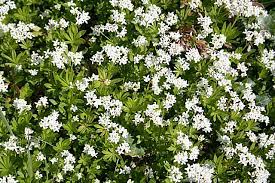Disclaimer: This Materia Medica is provided for informational purposes only and should not replace professional medical advice. Please consult with a qualified healthcare practitioner or herbalist before using any herbal remedies.
Materia Medica for Sweet Woodruff (Galium odoratum)
Introduction: Sweet Woodruff, known botanically as Galium odoratum, is a charming and versatile herb that has been used for centuries in traditional herbal medicine. As a professional herbalist, it is essential to have a comprehensive understanding of this herb’s properties, uses, and potential benefits, as well as any potential risks associated with its use. This exhaustive Materia Medica aims to provide you with a thorough overview of sweet woodruff from the perspective of an experienced herbalist.
Botanical Description:
- Botanical Name: Galium odoratum
- Common Names: Sweet Woodruff, Wild Baby’s Breath, Master of the Woods, Waldmeister (German)
- Family: Rubiaceae
- Parts Used: Aerial parts, primarily the leaves and stems
- Habitat: Sweet woodruff is native to Europe and Asia and is commonly found in woodlands, shaded areas, and along stream banks. It has naturalized in parts of North America.
Constituents: Sweet woodruff contains a variety of bioactive compounds, including:
- Coumarins (e.g., coumarin, umbelliferone): Responsible for the herb’s characteristic sweet, hay-like fragrance.
- Tannins
- Flavonoids
- Alkaloids
- Essential oils
Traditional Uses:
- Aromatic Herb: Sweet woodruff is primarily valued for its pleasant scent. Historically, it was used to make fragrant sachets, garlands, and potpourri.
- Culinary Uses: Sweet woodruff has been used as a flavoring agent in traditional European beverages, including May wine (Maiwein) and sweet woodruff syrup. It imparts a subtle vanilla-like flavor.
- Medicinal Herb: In herbal medicine, sweet woodruff has been employed for various therapeutic purposes, such as:
- Mild Sedative: Traditionally, sweet woodruff has been used to promote relaxation and alleviate insomnia.
- Digestive Aid: It may support digestion and relieve mild gastrointestinal discomfort.
- Topical Applications: Infused oils and poultices of sweet woodruff have been used for skin conditions, including minor wounds and insect bites.
- Anti-Inflammatory: Some herbalists believe that sweet woodruff possesses anti-inflammatory properties and have used it for conditions involving inflammation.
- Potential Cardiovascular Support: Due to its coumarin content, sweet woodruff has been explored for its potential to support cardiovascular health. However, caution is advised due to the anticoagulant properties of coumarins.
Preparation and Dosage:
- Infusion: Prepare a mild infusion using 1-2 teaspoons of dried sweet woodruff per cup of hot water. Steep for 5-10 minutes and drink as needed.
- Tincture: A tincture can be made with fresh or dried sweet woodruff. A typical dosage is 1-4 ml three times daily.
- Poultice: Apply a poultice made from crushed fresh leaves and stems to the affected area for external use.
- Caution: Sweet woodruff should be used in moderation due to its potential for liver toxicity when consumed in excessive amounts.
Safety and Contraindications:
- Pregnancy and Lactation: Avoid using sweet woodruff during pregnancy and breastfeeding, as its safety in these situations has not been established.
- Liver Health: Individuals with pre-existing liver conditions should exercise caution due to the potential for coumarin-related liver toxicity.
- Drug Interactions: Sweet woodruff may interact with blood-thinning medications due to its coumarin content. Consult a healthcare professional if you are taking such medications.
Conclusion: It’s important to approach sweet woodruff with a well-informed perspective. While it has a rich history of traditional use for its aromatic and potential medicinal properties, it should be used with care and moderation.





